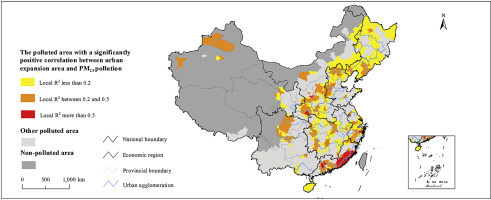当前位置:
X-MOL 学术
›
J. Clean. Prod.
›
论文详情
Our official English website, www.x-mol.net, welcomes your
feedback! (Note: you will need to create a separate account there.)
The relationships between urban landscape patterns and fine particulate pollution in China: A multiscale investigation using a geographically weighted regression model
Journal of Cleaner Production ( IF 9.7 ) Pub Date : 2019-07-22 , DOI: 10.1016/j.jclepro.2019.117744 Mengzhao Tu , Zhifeng Liu , Chunyang He , Zihang Fang , Wenlu Lu
Journal of Cleaner Production ( IF 9.7 ) Pub Date : 2019-07-22 , DOI: 10.1016/j.jclepro.2019.117744 Mengzhao Tu , Zhifeng Liu , Chunyang He , Zihang Fang , Wenlu Lu

|
Providing accurate assessments of the relationships between urban landscape patterns and PM pollution is essential for improving urban sustainability in China. Accordingly, this paper uses a geographically weighted regression model to reveal the relationships between urban landscape patterns and PM pollution at different scales in China. First, we identified the level of PM pollution in China and quantified the urban landscape patterns based on the landscape metrics in 2015. Then, we analyzed the relationships between urban landscape patterns and PM pollution using geographically weighted regression with the county as the basic analytical unit. Finally, the spatial characteristics of the relationships between urban landscape patterns and PM pollution were analyzed at the national, regional and provincial scales. We found that the PM pollution in China was closely related to urban landscape patterns, with obvious spatial heterogeneity. The total area with a significant correlation between the urban landscape patterns (which were measured using the percentage of urban landscape, edge density, and patch density) and PM pollution ranged from 2.07 × 10 km to 2.26 × 10 km, accounting for 42.55%–46.59% of the total PM-polluted area in China. The high correlations were concentrated mainly in five provinces, namely, Xinjiang, Shaanxi, Fujian, Chongqing and Guangdong. We also found that the relationships between urban landscape patterns and PM pollution were stronger in urban agglomerations. The total area with a significant correlation between the urban landscape patterns and PM pollution was 9.20 × 10 km, occupying 65.55% of the entire urban agglomeration area; this percentage was nearly 14% higher than the national average level. The strongest relationship was observed in the Northern Tianshan Mountains urban agglomeration. Contrasting with previous studies, our study fully considered the spatial autocorrelation and spatial differences between variables by using geographically weighted regression and clarified the spatial heterogeneity of the relationships between urban landscape patterns and PM pollution in China. Our findings imply that special attention must be paid to the urban landscape patterns in urban agglomerations during future urban development in China. Furthermore, effective regulations must be implemented to reduce the impacts of urban landscape patterns on PM pollution by controlling urban expansion and optimizing the spatial patterns of urban landscapes.
更新日期:2019-07-22











































 京公网安备 11010802027423号
京公网安备 11010802027423号